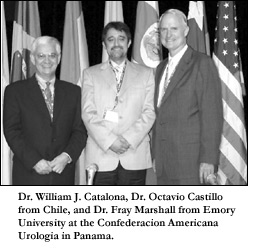Looking for Prostate Cancer Genes
Update: Prostate Cancer Research
The Urological Research Foundation supports Dr. Catalona’s collaborations in prostate cancer research with scientists across the country.
Also, the URF initiates and participates in studies on the genetics of prostate cancer. The specimens and data of Dr. Catalona are used by scientists in the most advanced research centers in the United States.
Findings from these collaborative studies are reported regularly at medical and scientific conferences and in journals. They contribute substantially to the progress being made in the diagnosis and treatment of prostate cancer.
While the material is technical in nature, QUEST would like to provide a lay version to our readers.
 At a recent CaP CURE conference, Dr. Catalona presented summaries of recent genetic studies conducted by his collaborative prostate cancer research group.
At a recent CaP CURE conference, Dr. Catalona presented summaries of recent genetic studies conducted by his collaborative prostate cancer research group.
“We are trying to find possible genomic regions associated with prostate cancer,” Dr. Catalona said in describing results from his study using pairs of brothers.
“We want to see if genetic markers located in specific chromosomal regions are linked to a predisposition to getting prostate cancer and/or to deciding the agressiveness of the prostate cancer.
The investigation used more than 500 brothers from over 200 families to see if pairs of brothers with prostate cancer share markers more often than expected, that is more than 50%.
If increased sharing of these markers is found, then the regions may contain genes for prostate cancer susceptibility or aggressiveness.
More than 10 scientific publications have resulted from these studies. First, a whole genome linkage study identified five chromosomal regions that were statistically linked to prostate cancer susceptibility. These findings were re-tested in a replication study in a different set of patients.
A subsequent linkage analysis using a different statistical approach (with covariates) also confirmed linkage to two other regions on chromosomes 1 and 4, previously reported by other research teams.
One of the strongest linkage signals was found on chromosome 16. Subsequent studies from collaborators Graham Casey and John Witte and others in Cleveland, Ohio narrowed this region to an area where genetic losses are found in approximately half of prostate cancer patients.
Linkage studies were also performed to find regions that may be associated with aggressive forms of prostate cancer. With additional fine gene mapping studies performed at the Marshfield Institute and in Cleveland, regions on chromosomes 7 and 19 proved to be significant.

The region on chromosome 7 was associated with early age-at-diagnosis of prostate cancer, high Gleason grade and stage, and a family history of prostate cancer. Further studies have been performed in Cleveland to narrow this region.
Hopefully, the region will be narrowed to a specific “candidate prostate cancer gene.”
Researchers in Cleveland have also conducted studies of genetic imbalance that has further narrowed this region to allow further studies of candidate genes.
RNAseL
Some of the most exciting findings from Dr. Catalona’s collaborative research group are connected to the gene RNAseL, located on chromosome 1, and a variant of this gene, R46Q2, which is associated with increased cancer risk. At least one copy of R462Q is carried by nearly 60% of the men in the study.
Men who carry this variant exhibit a three-fold reduction in RnaseL enzyme activity. Researchers estimate that nearly 13% of prostate cancers may be attributable to the R462Q variant.
“Because using genetic methods for detecting the R462Q variant are already available and assays for measuring the functional activity of the RNAseL have been developed by our Cleveland colleagues, then the potential is there for developing clinical tests for prostate cancer susceptibility and possible new methods of prevention and treatment,” Dr. Catalona said.
“We’re finding information that helps in understanding the disease and hopefully which will lead to better treatments or perhaps treatments involving genetics,” Dr. Catalona added.
Drs. Catalona, Brian Suarez and Jeffrey Milbrandt at Washington University have collaborated with Drs. Todd Golub, William Sellers, and Philip Febbo at MIT/Dana Farber Cancer Center at Harvard.
The collaborators in the Boston group have just completed the largest study of gene expression profiles of Dr. Catalona’s patients who have prostate cancer that has been cured and those who have cancers that have recurred.
“Most exciting findings are connected to the gene RNAseL.”
Data analysis is currently underway and will require the advanced informatics technology available at MIT.
Dr. Millbrandt’s laboratory was among the first to find that the gene, hepsin, is over expressed in prostate cancer.
Currently, several pharmaceutical companies are working on developing inhibitors of hepsin as a possible future treatment of prostate cancer.
Further studies with the MIT/Dana Farber group are underway to use newly-developed chips that contain single nucleotide polymorphisms (“snip chips”) to further narrow the regions in search of specific candidate genes.
Dr. Catalona’s research team lead by Dr. Suarez has also conducted case-control genetic association studies of the androgen receptor gene and replications studies of the Human Prostate Cancer Gene 2 (ELAC2/HPC2) gene to verify previous research from other centers.











